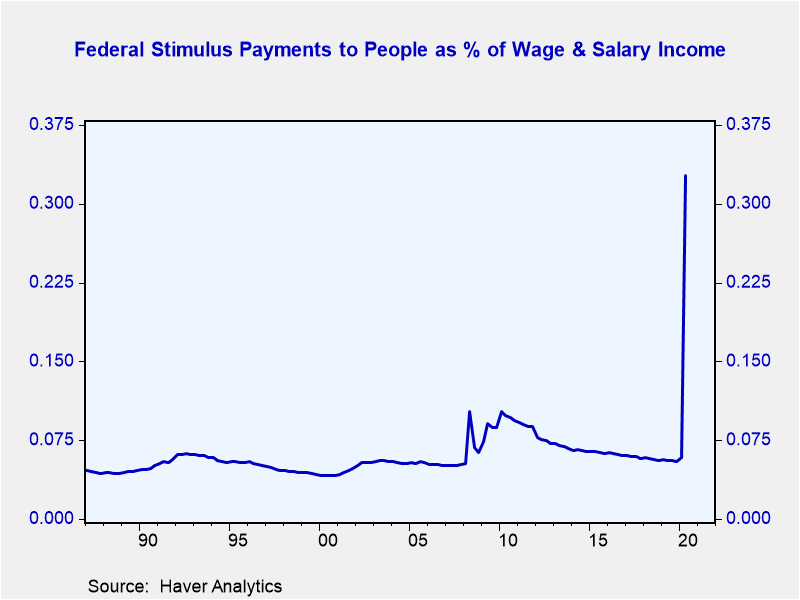 Global| Aug 12 2020
Global| Aug 12 2020Failure to Reach Deal on Federal Stimulus Plan Risks Consumer Spending Recession
|in:Viewpoints
Summary
Failure to reach a compromise on a broad federal stimulus plan creates a big "hole" in consumer’s cash flow. The "hole" is so big it raises the risk of substantial reduction, if not a recession, in consumer spending in the coming [...]
 Failure to reach a compromise on a broad federal stimulus plan creates a big "hole" in consumer’s cash flow. The "hole" is so big it raises the risk of substantial reduction, if not a recession, in consumer spending in the coming months.
Failure to reach a compromise on a broad federal stimulus plan creates a big "hole" in consumer’s cash flow. The "hole" is so big it raises the risk of substantial reduction, if not a recession, in consumer spending in the coming months.
Record Federal Stimulus in Q2
According to the Bureau of Economic Analysis (BEA), special federal payments to individuals (and small businesses) in Q2 totaled more than $ 3.2 trillion annualized. That boost to personal income resulted in a 7% quarterly gain in Q2, wiping out what would have been a 10% reduction based on record job losses, and reduction in hours worked and pay.
Included in those numbers are the direct stimulus payments to people, a weekly supplemental payment for unemployment, expanded unemployment payments to individuals who are not usually eligible for unemployment, forgivable loans to small businesses and non-profits to help cover payroll and other expenses, suspension of reimbursements paid to Medicare and suspension of interest payments on federally held student loans.
In Q2, the special federal payments to people (including small businesses) amounted to 25% of wage and salary income earned in the quarter. In other words, for every $4 of wage and salary income, people working and idled (and small business owners) received another $1 from the federal government.
According to the payroll employment data from the Bureau of Labor Statistics, there were 133.7 million people employed in Q2. That means the record federal stimulus payments were the equivalent of 33 million jobs.
The abrupt and sharp loss of income has not been lost on economic experts, even those that occupy the White House. Fearing a sharp drop in spending due to the loss of record federal stimulus payments the Administration’s economic team recommended the president sign executive orders to provide a temporary extension but smaller scale of unemployment compensation and a three month holiday in payroll taxes.
This band-aid plan is too small to fill the "holes" and also too slow in getting monies to people fast. That’s because the additional unemployment program will take several weeks to set-up and also require states to pay for one-fourth of the plan. But most states don’t have the monies to comply so some unemployed people might not see any benefit at all.
Businesses are undecided on the payroll tax holiday. That's because it will be difficult for them to implement since it only applies to part of their workforce, and it needs to be repaid at some point in 2021. As a result, many companies may opt-out, resulting in little or no short-term boost to consumer cash flow.
With each passing day, failure of Congress and the Administration to reach a deal on the federal stimulus plan raises the risk of a hard fall in consumer spending. Millions of people have not paid rent or mortgages over the last few months and the federal stimulus payments offered them a short-term "lifeline" just to sustain minimum household spending.
I have never been a believer in double-dip recessions. But the sharp drop in consumer income may make it a reality for investors.
Viewpoint commentaries are the opinions of the author and do not reflect the views of Haver Analytics.Joseph G. Carson
AuthorMore in Author Profile »Joseph G. Carson, Former Director of Global Economic Research, Alliance Bernstein. Joseph G. Carson joined Alliance Bernstein in 2001. He oversaw the Economic Analysis team for Alliance Bernstein Fixed Income and has primary responsibility for the economic and interest-rate analysis of the US. Previously, Carson was chief economist of the Americas for UBS Warburg, where he was primarily responsible for forecasting the US economy and interest rates. From 1996 to 1999, he was chief US economist at Deutsche Bank. While there, Carson was named to the Institutional Investor All-Star Team for Fixed Income and ranked as one of Best Analysts and Economists by The Global Investor Fixed Income Survey. He began his professional career in 1977 as a staff economist for the chief economist’s office in the US Department of Commerce, where he was designated the department’s representative at the Council on Wage and Price Stability during President Carter’s voluntary wage and price guidelines program. In 1979, Carson joined General Motors as an analyst. He held a variety of roles at GM, including chief forecaster for North America and chief analyst in charge of production recommendations for the Truck Group. From 1981 to 1986, Carson served as vice president and senior economist for the Capital Markets Economics Group at Merrill Lynch. In 1986, he joined Chemical Bank; he later became its chief economist. From 1992 to 1996, Carson served as chief economist at Dean Witter, where he sat on the investment-policy and stock-selection committees. He received his BA and MA from Youngstown State University and did his PhD coursework at George Washington University. Honorary Doctorate Degree, Business Administration Youngstown State University 2016. Location: New York.


